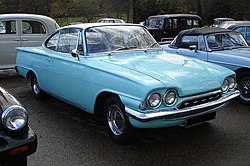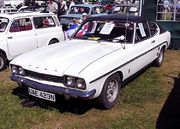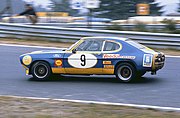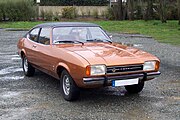


Ford Capri was a coupé style car from Ford of Great Britain sold between 1962 and 1964. Greater commercial success was enjoyed by the Capri produced by Ford of Europe from 1969 to 1986, and in Australia between 1969 and 1972. A third completely different vehicle bearing the name was produced by Ford in Australia from 1989 to 1994. Across these markets, three fundamentally different Ford models bearing the name Ford Capri were built, and these in various versions. There had previously been a Capri from the Lincoln division of Ford USA in 1952, though this was never badged as a Ford Capri.
Contents |
| Ford Consul Capri | |
|---|---|
 | |
| Production | 1961-1964 |
| Body style(s) | 2-door coupé |
| Engine(s) | 1340 cc Straight-4 ohv 1961 - 1962 1498 cc Straight-4 ohv 1962 - 1964 |
| Wheelbase | 99 in (2515 mm)[1] |
| Length | 170.75 in (4337 mm) |
| Width | 65.3 in (1659 mm) |
| Curb weight | 2100 lb (953 kg) approx |
| Related | Ford Consul Classic |
The first use of the name Capri by Ford of Great Britain was for a 2 door coupé version of the Ford Classic saloon. The Ford Consul Capri was introduced in 1961 but only officially went on sale in Britain in January 1962: it was discontinued in July 1964. Along with the Ford Classic it offered many then unusual features, such as four headlights, variable speed wipers, disc brakes, dimming dashboard lights, and a cigar lighter. It was proclaimed as "The First Personal car from Ford of Great Britain" (Ford of Great Britain, sales literature, December 1961) and its style was inspired by late 1950s United States car designs with rear fins. It had sweeping lines, a large boot space and a pillarless coupé roof. Initially available with a 1340 cc engine on 3 main bearings(model 109E): engine capacity was increased in August 1962 to 1498 cc (model 116E). The first 200 Capris were hand-made left-hand-drive cars for continental Europe. In Germany at the 1961 Frankfurt Auto Show, Ford sold 88 Capris. From 1961 to 1964 only 500 Capris were sold. The oldest of these handmade Capris from 1961 are in Germany. The Consul Capri 335 is one of the rarest cars from Ford.
In 1963 a GT version (also 116E; the same engine as in the Cortina GT) was introduced. Overall car was very expensive to produce and in the latter part of it's production was running alongside the very popular Ford Cortina, sales were disappointing and the Consul Capri was removed from sale after just two and a half years.
[edit] Ford Capri Mark I (1969–1974)
The first "Ford Capri" to bear that precise name was introduced in January 1969 at the Brussels Motor Show, with sales starting the following month. The intention was to reproduce in Europe the success Ford had had with the North American Ford Mustang; to produce a European pony car. It was mechanically based on the Cortina and built in Europe at the Dagenham and Halewood plants in the United Kingdom, the Genk plant in Belgium, and the Saarlouis and Cologne plants in Germany. The car was named Colt during development stage, but Ford were unable to use the name, as it was trademarked by Mitsubishi.
Although a fastback coupé, Ford wanted the Capri Mark 1 to be affordable for a broad spectrum of potential buyers. To help achieve that, it was available with a variety of engines. The British and German factories produced different line-ups. The continental model used the Ford Taunus V4 engine in 1.3, 1.5 and 1.7 L displacement, while the British versions were powered by the Ford Kent straight-4 in 1.3 and 1.6 L form. The Cologne V6 2.0 L served as initial range-topper. Until the end of the year, new sports versions were added: the 2300 GT in Germany, using a double-barrel carburettor and 125 PS (92 kW), and the 3000 GT in the UK, with the Essex V6, capable of 138 hp (103 kW).
In April 1970, Ford began selling the Capri outside Europe, in the North-American, South African and Australian markets. These versions were powered solely by the underpowered Kent 1.6 engine, but a Pinto straight-4 2.0 L replaced it in 1971. The North American version featured new headlights and bumpers, and carried no brand badge.
A new 2637 cc version of the Cologne V6 engine assembled by Weslake appeared in September 1971, powering the Capri RS2600. This model used Kugelfischer fuel injection to raise power to 150 PS (110 kW), and was the basis for the Group 2 RS2600 used in the European Touring Car ChampionshipFitted with the Weslake engine featuring their special all alloy cylinder heads. The RS2600 also received modified suspensions, a close ratio gearbox, lightened bodywork panels, ventilated disc brakes and aluminium wheels. The 2.6 L engine was detuned in September for the deluxe version 2600 GT, with 2550 cc and a double-barrel Solex carburettor.
Mark I facelift
The Capri proved highly successful, with 400,000 cars sold until 1970, and Ford revised it in 1972, to become what is known by enthusiasts as the Capri "Bis" or, in the UK, the "Mark 1 facelift" Capri.[citation needed] The car received a new and more comfortable suspension, rectangular headlights, enlarged taillights and new seats. The Kent engines were replaced by the Ford Pinto engine, and the previously UK-only 3000 GT joined the German lineup. In the UK the 2 litre V4 remained in use. The following year, 1973, saw the highest sales total the Capri ever attained, at 233,000 vehicles, and the 1,000,000th Capri sold in August.
In December, Ford replaced the RS2600 with the RS3100, with the Essex V6's displacement increased to 3098 cc. Unlike its predecessor, it used a double-barrel Weber carburettor, and reached the same 150 PS (110 kW). However, the car was still competitive in touring car racing, and Ford Motorsport produced a 100-model limited edition with this new engine. The Group 4 RS3100’s engine was tuned by Cosworth into the GAA, with 3412 cc, fuel injection, DOHC, four valves per cylinder and 435 hp (324 kW) in racing trim. The car also featured improved aerodynamics. Besides the racing RS3100, the GAA was also used in Formula 5000.
Ford Capri Mark II (1974–1977)
In February 1974, the Capri Mark 2 was introduced. After 1.2 million cars sold, and with the 1973 oil crisis, Ford chose to make the new car more suited to everyday driving, with a shorter bonnet, larger cabin and the adoption of a hatchback rear door. By the standards of the day the mk2 was a very well evolved vehicle with very few reliability issues.
Although it was mechanically similar to the Mark 1, the Capri 2 had a revised larger body and a more modern dashboard including a smaller steering wheel. The 2.0 L version of the Pinto was introduced in the European model, and was placed below the 3.0L V6, although it was more powerful. The Capri still maintained the large square headlights, which became the easiest way to distinguish between a Mark 2 and a Mark 3. Larger disc brakes and a standard alternator finished the list of modifications.
In order to keep the sporty appeal of the car, Ford introduced the John Player Special limited edition in March 1975, but in May 1976, and with sales decreasing, the intermediate 3.0 GT models disappeared to give way for the upscale 3.0 S and Ghia designations. In October 1976, production was limited to the Saarlouis factory only, and the following year the Capri left the American market, after 513,500 models sold.
Ford Capri Mark III (1977–1986)
The Capri Mark 3 was referred to internally as "Project Carla", and although little more than a substantial update of the Mark 2, it was often referred to as the Mark 3. Ford only formally adopted the designation after the model ceased production.[citation needed] The first cars were available in March 1978, but failed to halt a terminal decline in sales. The concept of a heavily facelifted Capri 2 was shown at the 1976 Geneva show: a Capri 2 with a front very similar to the Escort RS2000 (with four headlamps and black slatted grille), and with a rear spoiler, essentially previewed the model some time before launch. The Mark 3 featured improved aerodynamics, leading to improved performance and economy over the Mark 2 and the trademark quad headlamps were introduced.
At launch the existing engine and transmission combinations of the Capri 2 were carried over, with the 3.0 S model regarded as the most desirable model although in truth the softer, Ghia derivative with automatic rather than manual transmission the bigger seller of the two V6 engined models.
The 3.0 S was used extensively in the TV series The Professionals, with characters Bodie driving a silver 3.0 S and Doyle a gold 3.0 S, which was credited with maintaining interest in the car in the UK.
Ford began to focus their attention on the UK Capri market as sales declined, realizing the car had something of a cult following there. Unlike sales of the contemporary 4 door Cortina, Capri sales in Britain were to private rather than fleet buyers who would demand less discounts, allowing higher margins with the coupé. Ford tried to maintain interest in 1979 with "X Pack" options from the performance oriented Rallye Sport parts range. Although expensive and slow selling these proved that the press would enthusiastically cover more developed Capris with higher performance.
In 1981, the 3.0 V6 powerplant was dropped from the line-up, while a new sporty version debuted at the Geneva Motor Show, called the 2.8 Injection. The new model was the first regular model since the RS2600 to use fuel injection. Power rose to 160 PS (118 kW) giving a top speed of 131 mph (211 km/h), but the car still had a standard four-speed gearbox. The Capri 2.8 Injection breathed new life into the range and kept the car in production 2-3 years longer than Ford had planned. The four-speed gearbox was replaced with a five-speed unit early on – at the same time Ford swapped the dated looking chequered seats for more luxurious looking velour trim. A more substantial upgrade was introduced in 1984 with the Capri Injection Special. This development used half leather seating and included a limited slip differential. Externally the car could be easily distinguished by seven spoke RS wheels (without the customary "RS" logo since this was not an RS vehicle) and color coded grille and headlamp surrounds. At the same time the 2-litre Capri was rationalized to one model the 2.0 S, which simultaneously adopted a mildly modified suspension from the Capri Injection. The 1.6 model was also reduced to one model, the 1.6 LS.
Although the Capri no longer had a racing career, Ford of Germany developed a limited edition, left hand drive only, turbocharged model with 188 hp (140 kW), which could propel the car to 220 km/h (137 mph) in April 1982. This wild looking derivative featured widened bodywork and "RS" badging of the engine and wheels. Although rare and collectible it was not regarded as a car of equal stature to the later Tickford - the other Ford "official" turbo Capri.
The Tickford Capri used the 2.8 Injection (rather than the RS model which strangely used the Granada carburettor engine) and developed 205 hp (153 kW) this version also featured a luxury interior with optional full leather retrim and Wilton carpeting and headlining, large rear spoiler, color coded front grille, deeper bumpers and 'one off' bodykit designed by Simon Saunders, later of KAT Designs and now designer of the Ariel Atom.
The independent tuner, Turbo Technics also released a 200 hp (149 kW) version, and a new 230 hp (171 kW) evolution which came supplied with a specially built gearbox. The Tickford Capri pricing issues (covered later) meant that Ford also sanctioned the Turbo Technics conversion as semi-official, although only the German RS and British Tickford ever appeared in Ford literature as official Ford products.
Rear disc brakes were standard on the Tickford which featured numerous other suspension modifications. This model was essentially rebuilt by hand by Tickford at approximately 200 hours per car, several of those dedicated to reshaping the leading edge of the bonnet to mate with the redesigned grille and body kit. It's still regarded as one of the most collectible Capri models today although at the time it struggled to sell even 100 units, despite extensive research and development costs. One problem was the relative price difference to the standard Capri Injection. To put this in perspective, the cost of the basic car doubled which would translate to a €30,000 coupé, such as a BMW 3 Series, being sold at €60,000 — or BMW M3 money.
From November 1984 onwards, the Capri was sold only in Britain, with only right hand drive cars were made from this date. The 1.6 and 2.0 variants were rebranded with a new trim level – "Laser" – which featured a fully populated instrument pod, leather gear lever, leather steering wheel and an electric aerial along with colour-coded grille and mirrors. The last run limited edition "Brooklands" Green, 280 model, featuring a limited slip differential, full leather Recaro interior and 15 inch versions of the seven spoke 13 inch wheels fitted to the superseded Capri Injection Special. Ford originally intended to make 500 turbo charged vehicles (by Turbo Technics) complete with gold alloy wheels and name it the Capri 500 but a change of production planning meant a name change to Capri 280 as the cars were simply the last models ran down the production line. A total of 1,038 Capri 280s were built. Contrary to some reports these cars were not called "Capri 280 Brooklands", the latter name of the famous Surrey race track only being applied to the paint colour rather than the car itself.
When the last Capri was made on December 19, 1986, 1,886,647 cars had rolled off the production line. Production had ended at Halewood, UK in 1976 and the Capri was made exclusively in Germany from 1976 to 1986. Most of those (more than a million) were the Mark 1, mostly because the Mark 1 sold well in North America and Australia, while the Mark 2 and Mark 3 were only exported outside Europe (to Asia and New Zealand) in limited numbers.
The Capri is remembered for the classic advertising slogan "The car you always promised yourself". A North American advertising campaign featured a shorter line: "Capri: The Sexy European".





4 comments:
''From 1961 to 1964 only 500 Capris were sold'' Only if you don't count the other 18,000 or so. I also doubt that all the first 200 went to Germany, I know of 2 in Canada (the first known picure of a Capri published was of one being loaded onto a Canada bound freighter). At least 2 more in New Zealand and I have seen one in Italy.
Blackjack Games for free - DrMCD
Play a selection 경주 출장샵 of Blackjack 김제 출장마사지 games for free at DrMCD today! 아산 출장샵 Free! Blackjack is one of the most popular casino games available in the US, 이천 출장샵 so get ready 제주도 출장마사지 to play
High Flow Filters Cartridge,capsule filter tips,capsule filter sartorius click this link here now
Post a Comment